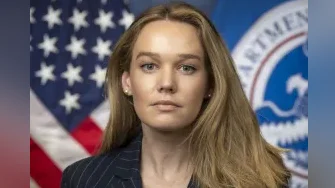The Congressional Record is a unique source of public documentation. It started in 1873, documenting nearly all the major and minor policies being discussed and debated.
“SECURE BORDER ACT OF 2011” mentioning the U.S. Dept. of Energy was published in the House of Representatives section on pages H3236-H3239 on May 30, 2012.
The publication is reproduced in full below:
SECURE BORDER ACT OF 2011
Mr. KING of New York. Mr. Speaker, I move to suspend the rules and pass the bill (H.R. 1299) to achieve operational control of and improve security at the international land borders of the United States, and for other purposes, as amended.
The Clerk read the title of the bill.
The text of the bill is as follows:
H.R. 1299
Be it enacted by the Senate and House of Representatives of the United States of America in Congress assembled,
SECTION 1. SHORT TITLE.
This Act may be cited as the ``Secure Border Act of 2011''.
SEC. 2. STRATEGY TO ACHIEVE OPERATIONAL CONTROL OF THE
BORDER.
(a) Strategy to Secure the Border Between the Ports of Entry.--Not later than 180 days after the date of the enactment of this Act, the Secretary of Homeland Security shall submit to the appropriate congressional committees a comprehensive strategy for gaining, within five years, operational control of the international borders between the ports of entry of the United States. The strategy shall include an analysis of the following:
(1) Staffing requirements for all border security functions.
(2) Investment in infrastructure, including pedestrian fencing, vehicle barriers, and roads.
(3) The use of unmanned aerial vehicles, camera technology, sensors, and other innovative technology as the Secretary may determine.
(4) Cooperative agreements with international, State, local, tribal, and other Federal law enforcement agencies that have jurisdiction on the northern border and southern border.
(5) Other means designed to detect, respond to, and interdict unlawful cross-border activity and to reduce the level of violence.
(6) A schedule for implementing security measures, including a prioritization for future investments.
(7) A comprehensive technology plan for major surveillance and detection technology programs, including a justification and rationale for technology choices and deployment locations.
(8) The recommendations made in the December 2010 Government Accountability Office report entitled ``Enhanced DHS Oversight and Assessment of Interagency Coordination is Needed for the Northern Border''.
(b) Securing the Border at Ports of Entry.--Not later than 180 days after the date of the enactment of this Act, the Secretary of Homeland Security shall develop metrics to measure the effectiveness of security at ports of entry, which shall consider, at minimum, the following:
(1) The number of infractions related to personnel and cargo committed by major violators who are apprehended by U.S. Customs and Border Protection at such ports of entry.
(2) The estimated number of such infractions committed by major violators who are not so apprehended.
(3) The required number of U.S. Customs and Border Protection Officers, Agricultural Specialists, and Canine Enforcement Officers necessary to achieve operational control at such ports of entry.
(4) Infrastructure improvements required to achieve operational control at such ports of entry, including the installation of nonintrusive detection equipment, radiation portal monitors, biometrics, and other sensors and technology that the Secretary determines necessary.
(5) The deployment of resources based on the overall commercial and passenger traffic, cargo volume, and threat environment at such ports of entry.
(6) The recommendations made in the December 2010 Government Accountability Office report entitled ``Enhanced DHS Oversight and Assessment of Interagency Coordination is Needed for the Northern Border''.
(c) Evaluation by Department of Energy National Laboratory.--The Secretary of Homeland Security shall request the head of an appropriate Department of Energy National Laboratory with prior expertise in border security to evaluate the measurement system required under subsection (b) to ensure its suitability and statistical validity for analyzing progress for the interdiction of illegal crossing and contraband at ports of entry.
(d) Consideration of Alternative Border Security Standards.--If in developing the strategic plan required under subsection (a) the Secretary of Homeland Security makes a determination to measure security between border ports of entry by a standard other than operational control, the Secretary shall request the head of an appropriate Department of Energy National Laboratory with prior expertise in border security to evaluate such alternative standard to ensure the suitability and statistical validity of such standard with respect to measuring the progress for the interdiction of illegal crossings and contraband that pass between such ports of entry.
(e) Reports.--Not later than 60 days after the date of the enactment of this Act and annually thereafter, the Secretary of Homeland Security shall submit the appropriate congressional committee a report on the following:
(1) A resource allocation model for current and future year staffing requirements that includes optimal staffing levels at all land, air, and sea ports of entry and an explanation of U.S. Customs and Border Protection methodology for aligning staffing levels and workload to threats and vulnerabilities across all mission areas.
(2) Detailed information on the level of manpower data available at all land, air, and sea ports of entry, including the number of canine and agricultural officers assigned to each such port of entry.
(f) Definitions.--In this Act:
(1) Appropriate congressional committee.--The term
``appropriate congressional committee'' means the Committee on Homeland Security of the House of Representatives and the Committee on Homeland Security and Governmental Affairs of the Senate.
(2) Major violator.--The term ``major violator'' means a person or entity that is or has engaged in serious criminal activities at any land, air, or sea port of entry, including possession of narcotics, smuggling of prohibited products, human smuggling, weapons possession, use of fraudulent United States documents, and other offenses serious enough to result in arrest.
(3) Operational control.--The term ``operational control'' has the meaning given such term in section 2(b) of the Secure Fence Act of 2006 (8 U.S.C. 1701 note; Public Law 109 367).
The SPEAKER pro tempore. Pursuant to the rule, the gentleman from New York (Mr. King) and the gentleman from Mississippi (Mr. Thompson) each will control 20 minutes.
The Chair recognizes the gentleman from New York.
General Leave
Mr. KING of New York. Mr. Speaker, I ask unanimous consent that all Members have 5 legislative days within which to revise and extend their remarks and include any extraneous material on the bill under consideration.
The SPEAKER pro tempore. Is there objection to the request of the gentleman from New York?
There was no objection.
Mr. KING of New York. Mr. Speaker, I yield myself such time as I may consume.
I would just suggest to the ranking member, since we are running short on time, I'm going to abbreviate my remarks. I know that your eloquence is unbounded, but I will try to restrict myself.
Mr. Speaker, H.R. 1299, the Border Security Act of 2011, requires the Secretary of Homeland Security to develop a strategy to gain operational control of the border within 5 years.
I want to commend Congresswoman Miller, who's the chair of the Subcommittee on Border and Maritime Security, for her leadership on this issue.
Border security is an integral element of homeland security. We must secure our borders. Since 2004, Congress has allocated billions of dollars to secure the border through investments in personnel, technology, and infrastructure; however, our borders remain vulnerable.
We know from the documents made public after the Abbottabad raid on Osama bin Laden's compound that al Qaeda continues to examine crossing the border to gain access to the U.S. It is critical that the Department produce a comprehensive strategy to gain operational control over the border.
This legislation is commonsense legislation. It has bipartisan support. I urge my colleagues to support it.
I reserve the balance of my time.
Mr. Speaker, H.R. 1299, The Border Security Act of 2011, requires the Secretary of Homeland Security to develop a strategy to gain operational control of the border within 5 years.
I would like to thank Congresswoman Miller, Chair of the Subcommittee on Border and Maritime Security, for her leadership on this issue.
Border security is an integral element of Homeland Security. We must secure our borders to prevent drug smugglers, terrorists, and others who pose a threat to the Homeland from entering the Country.
Since 2004, Congress has allocated billions of dollars to secure the border through investments in personnel, technology, and infrastructure. Through such investments, the size of the U.S. Border Patrol has doubled to more than 21,000 agents; almost 700 miles of vehicle and pedestrian fencing have been built; and significant investments have been made in camera detection technology. Without question, these investments have significantly increased security at the border.
However, our borders remain vulnerable and attractive for illegal aliens, criminals, and drug smugglers. We know from documents made public after the Abbottabad raid on Osama bin Laden's compound that al Qaeda continues to examine crossing the border to gain access to the United States.
It is critical that the Department of Homeland Security produce a comprehensive strategy to gain operational control over the border. As we move forward, Customs and Border Protection should explain what technology is being acquired, where it is being placed, and how those choices will fit into a comprehensive strategy to secure the border.
I am concerned that DHS has determined that they will no longer share operational control numbers with Congress as they have always done in past years in the annual budget submission. This legislation will ensure that these figures continue to be shared with Congress and that a National Laboratory will evaluate any new metrics developed by CBP.
We cannot continue to make ad hoc investments in border security; rather, border security funds should only be allocated as part of a larger strategic plan that gets us closer to a legitimately secure border both at and between the ports of entry.
This is a common sense bill, and I urge my colleagues to support it.
{time} 1750
Mr. THOMPSON of Mississippi. Mr. Speaker, I rise in support of H.R. 1299, the Secure Border Act of 2011, and I yield myself such time as I may consume.
This bill would require the Secretary of Homeland Security to submit to Congress a comprehensive strategy for gaining operational control of our borders within the next 5 years. This bill defines operational control as the prevention of all unlawful entries into the United States, including entries by terrorists, other unlawful aliens, instruments of terrorism, narcotics, and other contraband.
While this is a laudable goal, it is also extraordinarily ambitious, and the bill authorizes no additional resources to achieving this goal. I am pleased, however, that the bill would require the Secretary to submit to Congress a resource allocation model for Customs and Border Protection staffing requirements at all land, air, and seaports of entry. This is important information that our committee has repeatedly requested from CBP on a bipartisan basis but has not yet received.
With that, Mr. Speaker, I reserve the balance of my time.
Mr. KING of New York. Mr. Speaker, I yield such time as she may consume to the distinguished chair of the subcommittee, the gentlelady from Michigan (Mrs. Miller).
Mrs. MILLER of Michigan. I thank the gentleman for yielding.
Mr. Speaker, among the enumerated powers of the Constitution, providing for the common defense is, in my mind, the most important responsibility of the Congress. A key part of the common defense, of course, is ensuring that we secure the Nation's borders.
H.R. 1299, the Secure Border Act, moves the Nation closer to a more secure border by requiring the Department of Homeland Security to develop a plan to gain operational control of the border within 5 years. As part of that plan, the Department must account for staffing requirements, investments and infrastructure, and the justification and rationale for technology choices and deployment locations.
Since 9/11, this Nation has spent billions of dollars to increase security along our borders. We've doubled the size of the Border Patrol; built 700 miles of fence; and have invested in technology, such as UAVs and a wide array of surveillance equipment, for use along the border. Most of these investments have been worthwhile. Yet, instead of spending money in an ad hoc fashion, the Department of Homeland Security needs to develop a comprehensive and coherent plan to achieve control of the border while taking into account personnel, technology, and infrastructure needs. The need for a comprehensive strategy is apparent as previous border security efforts succeeded in shifting smuggling and illicit activities from urban areas of the Southwest border to more rural and remote areas, such as Arizona. However, this balloon effect has only succeeded in shifting the problem.
How we determine or measure what a secure border looks like has been the subject of a lot of debate, but the fact remains that the Congress and the American people should have a verifiable way to determine if we are making progress along the border. For years, we've relied on operational control as sort of a proxy for border security, and it has become a de facto term, but at the last count, only 44 percent of the Southwest border was under operational control, and less than 2 percent of the northern border was adequately secured.
In 2010, the Department of Homeland Security stopped reporting the numbers of miles of border under operational control, and as yet has really not supplied an alternative measure of border security to replace the discarded operational control measure. Just a few weeks ago, the Border Patrol released its new 2012 strategic plan, which makes no mention of operational control.
It is clear, Mr. Speaker, that the Department believes operational control is probably not the right measure to describe security at the border, and is working on something called the ``border condition index,'' which is supposed to be a holistic measure to inform our border security efforts. I think we are all open to a new, more robust standard if it supplements operational control and better describes what is happening with security at our border.
To this point, I don't think we can automatically assume that this new measure stacks up against operational control. With an issue this important, we just can't change the rules if we don't like the results. So, if the Secretary of the Department of Homeland Security decides to use a measure other than operational control, this bill would require that any other measure of border security would be vetted by a national laboratory with prior expertise in border security. I think that boils down to ``trust but verify.''
Security along the border is more often than not described in terms of fences, Border Patrol agents, UAVs, and camera towers. However, that is only one side of the story. We also need to increase security at our ports of entry--the conduit to much of the commerce and cargo that sustains our way of life. This bill requires the Secretary to develop a measure which gauges our progress at the points of entry so that, when combined with operational control or its successor, we have a very full picture of our border security.
Mr. Speaker, the men and women of the United States Border Patrol and the U.S. Customs and Border Protection have a very difficult job. I know that we all want to thank them for the very hard work that they do in some very demanding conditions to help secure our Nation. Certainly, it is our hope that the requirement for a comprehensive strategy will inform the Congress of the resources needs of the Department of Homeland Security, will give the men and women on the border the tools that they need, and will move us toward a more secure border both at and between the ports of entry.
I certainly would encourage all of my colleagues to support this bipartisan legislation.
Mr. THOMPSON of Mississippi. Mr. Speaker, I have no more speakers if the gentleman from New York is prepared to close.
Mr. KING of New York. Ranking Member, I have one further speaker.
Mr. Speaker, I yield 3 minutes to the gentleman from Texas (Mr. Poe).
Mr. POE of Texas. Thank you for yielding the time, and I appreciate Mrs. Miller for offering this legislation.
Having been a resident in Texas, a border State with Mexico, I see firsthand the situation on the border. We hear everything politically from ``the border is safe'' to ``it's a war zone,'' or somewhere in the middle. We actually do have a border security problem. Here are just a couple of statistics to show you how the border is so porous:
In our Federal penitentiaries, there is a group of people called
``criminal aliens.'' These are people who are illegally in the country and commit a felony in the United States. Twenty-five percent of the people in our Federal penitentiaries are criminal illegal aliens--
illegally in the country, convicted and sent to our Federal penitentiaries. I regularly go and visit with our border sheriffs, and I ask them periodically, How many people in your jails are foreign nationals? The latest statistic that 17 border sheriffs in Texas gave me was: 34.5 percent of the people in our jails are foreign nationals.
So, yes, that crime comes into the United States is just one aspect of the lack of border security. But there is more.
I recently met with some ranchers down on the Southwest border. The owner of this ranch on the border comes out to meet me, and he is wearing a bulletproof vest. Yes, he has to wear a bulletproof vest on his own land because the drug cartels come through his land, and it's dangerous, which is just one more example of the porous border that we have.
And most recently, to show that the border is porous and that what happens in Mexico doesn't stay in Mexico, a couple of weeks ago, there was a family in our church back in Texas who had this problem: Their cousins in Mexico had been kidnapped by the Zeta drug cartels and held for ransom. The family here in the United States, in Texas, paid the ransom to get the two cousins back. The drug cartels, the Zetas, they murdered them anyway.
So we have the problem of kidnappings taking place; we have the problem of extortion; and we have the problem of cross-border crime--
but it is all because of the fact that the border needs to be more secure than it is. A plan is a good idea. A plan to actually address all of these issues of a porous border is something that's long overdue, but I'm glad to see that we're moving in that direction--to have a plan so that we know exactly what will take place and how we will protect our borders.
After all, the job of the Federal Government is to protect the national security.
Mr. THOMPSON of Mississippi. In closing, I thank the lead sponsor of this bill, the gentlewoman from Michigan, Representative Miller, for her leadership on border and maritime issues and for her willingness to work on a bipartisan basis in areas of shared concern. I support the bill.
With that, I yield back the balance of my time.
Mr. KING of New York. Mr. Speaker, devising a comprehensive plan to secure our Nation's borders is the first step on the road to a more secure homeland. This bipartisan bill is a good start, and I ask my colleagues to support its passage.
I yield back the balance of my time.
Mr. GINGREY of Georgia. Mr. Speaker, I rise today as a proud cosponsor of H.R. 1299, the Secure Border Act of 2011, authored by my good friend, Candice Miller, and urge my colleagues to support it.
This bill requires the Department of Homeland Security to develop a comprehensive strategy for gaining control of our borders at all ports of entry. In developing that strategy, an analysis of current security effectiveness will help define the needs and requirements of an implementable border security blueprint.
Mr. Speaker, the reason this is necessary is because illegal immigration is one of the biggest crises facing our nation and securing our borders is of paramount importance.
The Government Accountability Office recently reported that less than half of our southwest border is under operational control. At the same time, only 32 percent of our northern border operates at an
``acceptable'' security level.
Mr. Speaker, keeping our nation safe is the federal government's chief responsibility, and that's why it is so important that we pass this legislation.
I ask my colleagues to join me in supporting this bill.
The SPEAKER pro tempore. The question is on the motion offered by the gentleman from New York (Mr. King) that the House suspend the rules and pass the bill, H.R. 1299, as amended.
The question was taken; and (two-thirds being in the affirmative) the rules were suspended and the bill, as amended, was passed.
A motion to reconsider was laid on the table.
____________________







